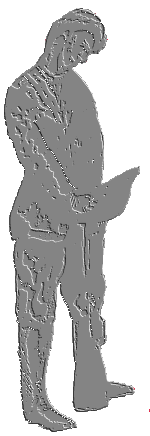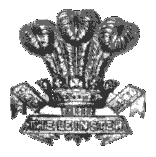 |
THE IRISH IN UNIFORM
THE LEINSTER REGIMENT |
 |
Men of the 2nd. Batt., The Leinster Regiment enjoy a snack in France, 1917 (IWM) |
| The Leinster Regiment had its
roots in two Regiments of Foot of The British Army, the
100th. and the 109th. Between 1761 and 1818, five regiments caried the number 100, two of which were recruited in Ireland. One of these was raised in 1805 and consisted of entirely Irish personnel. When transferred to the control of the British Establishment, it was known as The 100th. County of Dublin Regiment. It served in Canada from 1805 to 1812, when its title was changed to "The 100th" or "HRH The Prince Regent's County of Dublin Regiment". It then fought in The American War of 1812, and during that campaign captured Fort Niagara. Upon its return to Europe, the regiment took part in the Battle of Waterloo against Napoleon of France, and was then disbanded in England in 1818. There was then no regiment numbered 100 until 1858. Although the Canadians had offered to send a regiment to serve in The Crimean War, the British Government thought this unecessary. When the Canadians again offered troops at the breakout of "The Indian Mutiny", an infantry regiment of 1,200 men was raised and named The 100th. Prince of Wales' Royal Canadian Regiment, based in Quebec. Its Adjutant was Major Alexander Roberts Dunn, V.C., who had won two Victoria Cross medals in "The Charge of the Light Brigade" in 1854. (For details, follow the link to The Victoria Cross Reference Site on this site's LINKS PAGE) The Regiment's first colours were presented to it by the youthful Prince of Wales in 1859 before the troops were sent to serve in Gibraltar and Malta until 1866. From 1866 until 1868, The Leinsters were in Canada. The Leinsters then returned to England for two years and in 1874 went to Ireland. Their first tour of duty in India was from 1877 to 1894. When the British Army was re-organised in 1881, The 100th. Regiment was re-named the 1st. Battalionm The Prince of Wales' Leinster Regiment (Royal Canadians) and their home Depot became Birr, in County Offaly, Ireland. There was opposition from the men of The Leinsters when the wearing of khaki uniforms was introduced in place of the white hot weather uniforms worn previously by The British Army. In 1887, The Countess of Dufferin presented new colours to the regiment, and the old colours with their battle honour "Niagara" were sent to Canada and kept in The Library of Parliament in Ottawa. Dominion Day on 1st. July was celebrated as a holiday by The Royal Canadians, and maple leaves were sent from Canada to the regiment to be worn behind cap-badges on that day each year. which were joined together in 1881 as the 1st. and 2nd.Battalions of The Prince of Wales' Leinster Regiment. The Regimental Badge incorporates a plume of three ostrich feathers, which is the badge of a Prince of Wales, together with his motto "Ich Dien" ("I serve"). The 1st. Battalion, The Leinster Regiment was stationed at Tipperary Town Barracks from 1896 to 1897. The 2nd. Battalion of The Leinsters returned from India in1911 and was then stationed in Cork. From there, it went to England and then to France just afterthe outbreak of Word War I, landing at St. Nazaire on 12 September 1914. The regiment fought in Flanders and Northern France thoughout The Great War, mostly with the 24th. Division, apart from a few months secondment to the 16th. Division early in 1918. The 3rd. Battalion also saw service on The Western Front in France during World War I. Lieutenant John Vincent Holland, from County Kildare was awarded The Victoria Cross "for most conspicuous bravery" at Guillemont, France on 3 September 1916. No less than three men of the 2nd. Battalion of The Leinster Regiment won the supreme award for bravery, the Victoria Cross medal, during The First World War. Corporal John Cunningham, from County Tipperary was awarded The V.C. "for conspicuous bravery" on 12 April 1917 at Bois-en-Hache, France. He died there in a Field Hospital on 16 April of wounds received during his heroic exploit of 12 April. Private Martin Loffat from Sligo was awarded The V.C. "for conspicuous bravery" on 14 October 1918 at Ledeghem, Belgium; and Sergeant John O'Neill, MM, was awarded The V.C. for his deeds in action at Moorseele, Belgium, also on 14 October 1918. (More details of the citations regarding the award of these V.C.'s can be found via the 'Tipperary medals' page of this website, or via the 'links' page) In 1914 the 1st. Battalion of The Leinster Regiment was serving in Fyzabad, India and sailed from Bombay to England in October, arriving on 16 November. It landed in France in December 1914, as part of The 27th. Division, and fought with them until December 1915, when it was transferred to The Middle East theatre of war. In September 1917, the 1st. Battalion of The Leinsters went to Egypt and in late 1918 joined the 10th. Division in Palestine. The Battle Honours awarded to The Leinster Regiment for 'The Great War' of 1914-1918 read as follows: 'Armentiers 1914', 'Ypres 1915-1917-1918', 'Somme 1916-1918', 'Guillemont', 'Vimy 1917', 'Messines 1917', 'St. Quentin', 'Macedonia 1915-1917', 'Gallpoli 1915', 'Jerusalem'. |
| Use this button to go to the Navigation Buttons at the top of this page. | |
This
site webcrafted for The Fame of Tipperary Group,
Tipperary Town, County Tipperary, Ireland by the WebWizards© at The
Plug-in Office ®,, e-mail to plugin@iol.ie All text, backgrounds, graphics, images Copyright © 2000 WebWizards or as acknowledged. |
|